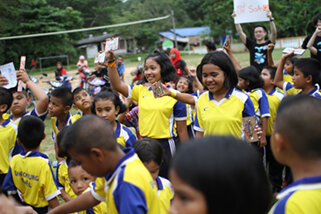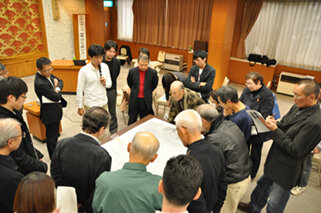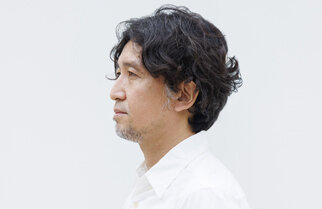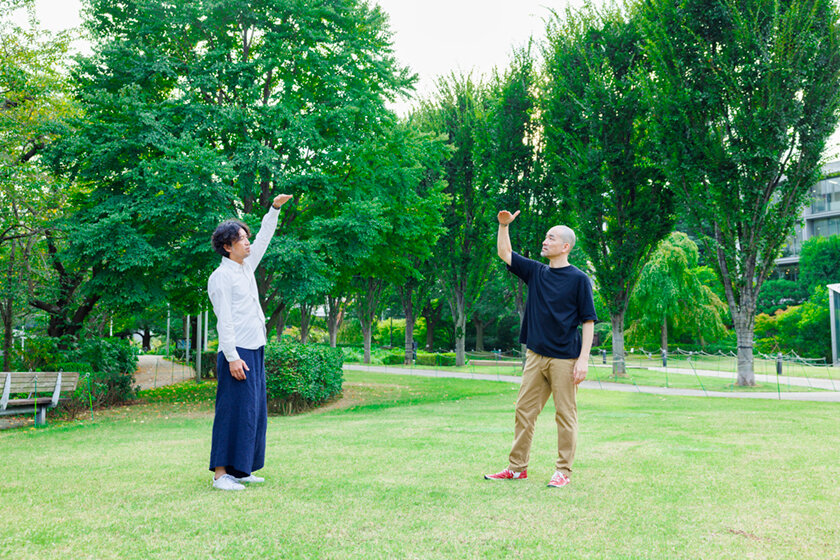
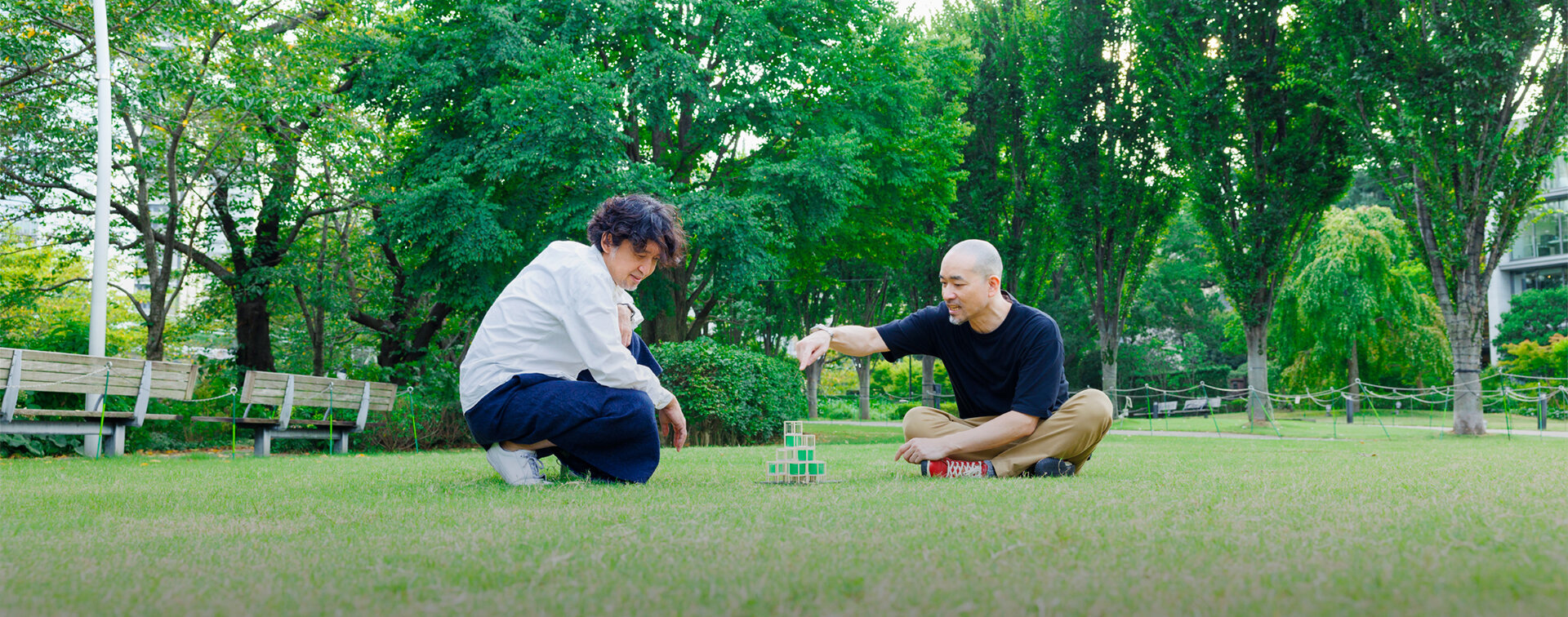
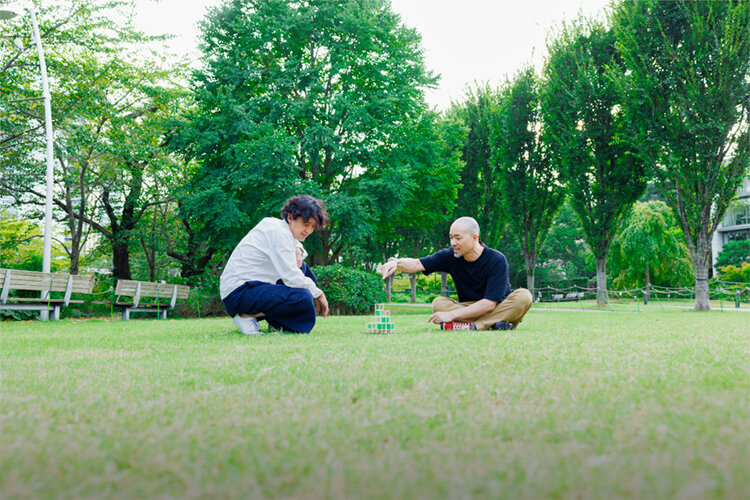
INTERVIEW
141
ENERGY MEETDesign Unit
Change Roppongi from a Consumer of Energy to a Producer
Not “Tokyo” but “Roppongi.” Start on a small scale.
The design unit ENERGY MEET, active mainly in Japan and Thailand, bonds energy to society with design through a unique concept they call “energy design.” At Tokyo Midtown DESIGN TOUCH 2022, they will be exhibiting an experimental installation that explores the possibilities of urban agriculture. With the rising awareness of environmental issues, the spotlight is on energy now more than ever. How does ENERGY MEET incorporate design concepts into these matters so as to provide potential solutions? We had Masato Ashida and Takuya Onishi answer this question, citing examples such as the DESIGN TOUCH installation as well as other past projects.
Design that draws together urban dwellers and agriculture
Takuya OnishiWe are exhibiting an agriculture-themed installation entitled F.A.R.M. -Future Agricultural Rights for Mankind- at Tokyo Midtown DESIGN TOUCH 2022. "Energy design" is the concept that we work with, but "energy" covers such a broad range, doesn't it? It ultimately boils down to cyclic design, but for a long time we had a hunch that agriculture would eventually become a factor in the context of energy design.
For example, the production of animal protein requires massive amounts of energy and freshwater. It also produces a lot of greenhouse gasses, which is too much of a burden on the environment. But sometimes agriculture is also pointed out as a burden on the environment and a cause of the destruction of nature. With agriculture as the central theme, we wanted to use design to present the concept of cyclic systems in a readily understandable way, so that we could all think about agriculture together. That was what inspired the idea for this installation.
Tokyo Midtown DESIGN TOUCH 2022
An event held every fall under the concept of "enjoying design through all five senses." Marking its 15th iteration, the event theme this year is "Design for Sustainable Future." Today, people's lives are changing drastically, and values are being perceived in new ways. What can we do to preserve things that are truly important to us? The event will use design to search for clues for making a sustainable future. Runs from October 14 (Fri) to November 3 (Thu/Holiday), 2022.
https://www.tokyo-midtown.com/jp/event/designtouch/en.html
Masato AshidaI was contemplating how to embody that idea through design, and thought about how in the past agriculture was a very familiar thing, something that people might have done in the midst of their everyday lives. But as society develops and populations grow with more division of labor in social systems, people naturally get detached from agriculture. It's one the characteristics of a highly developed society. I live in Tokyo, and you never get the opportunity to see a rice paddy in the middle of the city, do you? That's why I wanted to exhibit an agriculture-themed installation in Roppongi, and present a design that will encourage visitors to think about the relationship with agriculture and bring people closer to it in a new way.
F.A.R.M. -Future Agricultural Rights for Mankind-
An experimental installation that rearranges the farm into a vertical configuration to open up new possibilities for urban agriculture and deliver the first-hand practice of agriculture to all. It breaks down the various elements required for agriculture such as cultivation beds and energy sources into units. The design allows these units to be stacked together like blocks to easily construct a cyclic system that works as agriculture.
Put together your very own agricultural structure to incorporate into the urban cyclic system
OnishiWe designed F.A.R.M. to reintroduce agriculture to urban dwellers whose lives have become detached from farming in a fun and readily understandable way, and also invite people to actively participate. All kinds of cyclic systems are involved in agriculture. So to start off we broke it down into its various elements such as water, light, and soil. We put each of those elements necessary for agriculture into separate 40 x 40 x 40 centimeter wooden frames that can be put together like Legos. For example, you can create your very own agricultural unit such as by combining a water supply tank with soil cultivation or hydroponics and adding LED and solar panel blocks. Stacking the blocks vertically could be applied for use in skyscraper facades, and the appeal is that these can be set up in places with limited space.
AshidaAgriculture is evolving in all kinds of ways now beyond the conventional method of planting seedlings in soil and harvesting the crops. Using those new technologies, we envision our units to enable growing produce without having to own land.
OnishiThe theme for this year's DESIGN TOUCH event is "Design for Sustainable Future." Considering that the keywords for the event are "cycle" and "sustainable," it would defeat the purpose if the installation became trash at the end of the event. That's why we collaborated with two high schools on this project so that once the exhibition ends, they can take over with the units and continue this hands-on agricultural experience. The installation itself is meant to be part of a cycle that will go on to the future.

There are no excess plots of land. But walls may provide possibilities.
AshidaIn the initial stages of designing F.A.R.M., we thought about how people could possibly practice agriculture in urban areas. In recent years some people have rooftop farms, while others go to the suburbs on the weekends to engage in agriculture. As you might be able to tell from this, urban areas such as Tokyo have close to no excess plots of land. However in terms of surface area, I think there is far more wall area than land area. There is a limit to how much produce you can harvest per square meter, so you need to find a fair amount of space to increase harvest volume. In urban areas, it may be more realistic to have a future where we take over wall spaces and cultivate farms there.
Roppongi Hills Rooftop Garden
Roppongi Hills operates a rooftop garden roughly 1,300 square meters in size on top of the Keyakizaka Complex (Toho Cinemas Roppongi Hills). With the theme of a traditional Japanese farm, the garden includes a rice paddy and vegetable garden where harvesting and other seasonal events are held.
The design of blocks stacking on top of each other includes the idea that it can be customized any way you want, as well as the potential for more widespread application by creating vertical farms that use the blocks as architectural framework. Whether for environmental or aesthetic considerations, there have actually been more buildings that are adding greenery to walls or have balcony-like green spaces. Converting these green spaces to cultivate produce would create urban farms, and I think there's potential for three-dimensional use of space, in terms of the technology being available as well.
OnishiLand on Earth can roughly be described as being one-third forest, one-third arid desert, and one-third agricultural grassland. Meanwhile, they say cities only take up around 1% of the total land area. This means that no matter how much we strive to farm in cities, it might not have much significance. That being said, the surface area available is still pretty substantial if you also include the buildings, so we would like to explore the possibilities that are left to us.
Creating spaces where people can MEET is another role played by design
OnishiOne of our projects for bonding energy to society is called ENERGY Gift mini. It's something I started with teachers at King Mongkut's University of Technology Thonburi (KMUTT) in Thailand where I once worked as a lecturer, and it gives the gift of energy to remote areas in Thailand that have no electricity. We had electric engineering students in Thailand and design students in Japan collaborate to develop a solar lantern, which were assembled with children from the community that received the energy gift.
ENERGY Gift mini
A support project that delivers solar lanterns designed and developed mainly by students from Bangkok and Japan to children on a remote island in Thailand who struggle to study after dark due to having no electricity. By planning the entire process from designing the lantern to organizing the event for delivering them to the children, the project builds a sustainable support program for regions that have a national infrastructure gap.
AshidaIn Japan, we have several ongoing projects that explore community development through energy. The one we have been involved in the longest is the project in Obuse Town in Nagano Prefecture, which is currently in its tenth year. We are working with local government on this project, which initial started due to the nuclear power plant accident during the 2011 Tohoku Earthquake and Tsunami. Obuse is a small town with a population of approximately 12,000 people that has no choice but to depend on electric companies and other municipalities for their energy. We have launched various endeavors to help Obuse gain local energy independence by becoming an environmentally advanced city. Ten years ago, we started up the Obuse Energy Meeting. There were a lot of people there who had not heard about natural energy, so we started off by watching relevant films with residents and inviting experts to help learn about these issues. By now the people there are quite familiar with the concept. In 2018, we set up a small-scale hydroelectric plant in the town and this year we worked with the whole of Obuse Town to devise a grand vision that set goals for environmental issues including energy and garbage-related problems.
The Obuse Energy Meeting
A project that Obuse Town in Nagano Prefecture started in 2012 from a desire to "locally generate the energy they use." Their slogan is "let's generate a town that generates." Members include residents, local government, and experts who discuss undertakings such as the infrastructure development of natural energy and building a decentralized energy system. In October 2018, a small-scale hydroelectric plant commenced operations in Matsukawa, Obuse.
OnishiIn terms of energy and society, we mainly focus on creating collaborative platforms. Some of our prominent projects are up on our website, and they're all collaborations with universities, companies, or local government. That's why we're called ENERGY MEET, because we want to push projects forward together with others and create opportunities to meet people. Creating a team that can implement projects in collaboration with all kinds of people is just another role that design plays.
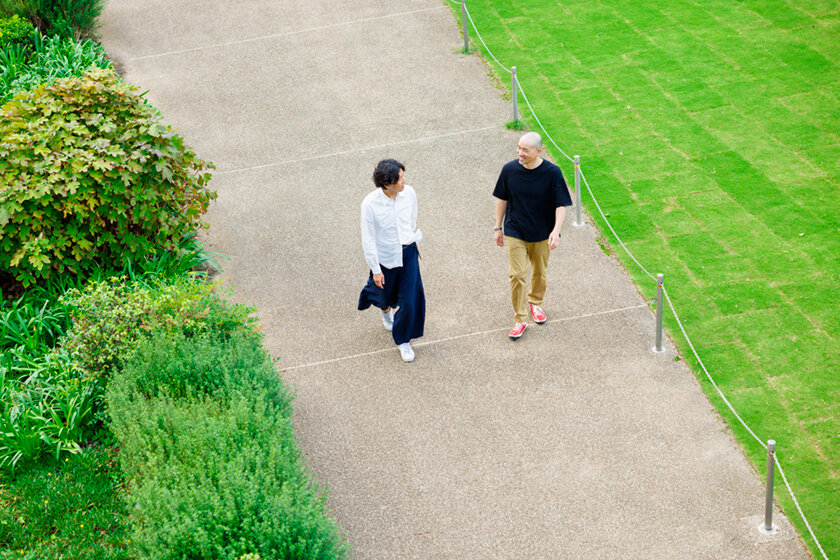
Downscaling is the future of cities
AshidaTokyo isn't the only city that's getting massively bloated. It's happening everywhere around the world. I think a lot of technology up until now has been about ramping up scale and unifying the world into one big whole. But now that everyone has smartphones and individuals are capable of doing a lot more on their own, I think things are starting to trend towards downscaling. Take electricity for example. Up until now, the only option was to buy from electric companies, but now you can make your own power using solar panels. Technology is scaling down to focus more on individuals, and networks are integrating to allow more individuals to connect with each other. This will no doubt require new types of urban models.
The biggest challenge then will be figuring out what to do with the cities that have gotten too big. The kind of energy and community development project we are doing in Obuse Town only works because it's on a small scale with a population of 12,000 people. It can't be applied to Tokyo, which would be too big of a scale. I think the future of cities lies in how we can downscale those cities that have become bloated with little room for innovation. So instead of thinking about it with Tokyo as a framework, I think there would be more we could do if we broke the city down into individual areas like Roppongi.
Reconsidering efficiency in urban design
OnishiI have this anecdote that really hits that message home. I do research on raising crickets, and I always order my crickets from a pet store on Amazon. Actually, that pet store is very close to my university lab in Setagaya. But when the store receives the order they apparently take the crickets to the Setagaya collection center, and when I checked the delivery route the package goes all the way to Haneda once, then returns to the Setagaya collection center and finally get delivered to my lab. The urban design is such that this is the "efficient way" of doing things. But if more local areas could assess this kind of thing independently, the package should be delivered straight to the lab upon arrival at the collection center with a more lateral communication system. So the way things are right now, we aren't doing the poor crickets any favors.
AshidaThe same can be said for power supply. Electric current can be either direct current (DC) or alternating current (AC). Because AC power can be sent over long distances, power required in cities can be generated in distant locations. To use electricity in cities generated in that way, we have to use AC adapters to convert the current into DC. Considering the energy that is lost in the process, the best method would be to keep things local, as in generate DC power and use it as-is nearby. For example, one possible strategy is to divide cities into new zones based on the area that is within a power plant's supply range. The possibility of supplying DC power is currently receiving international attention, and I think it relates in a way to the idea of downsizing the scale of cities.
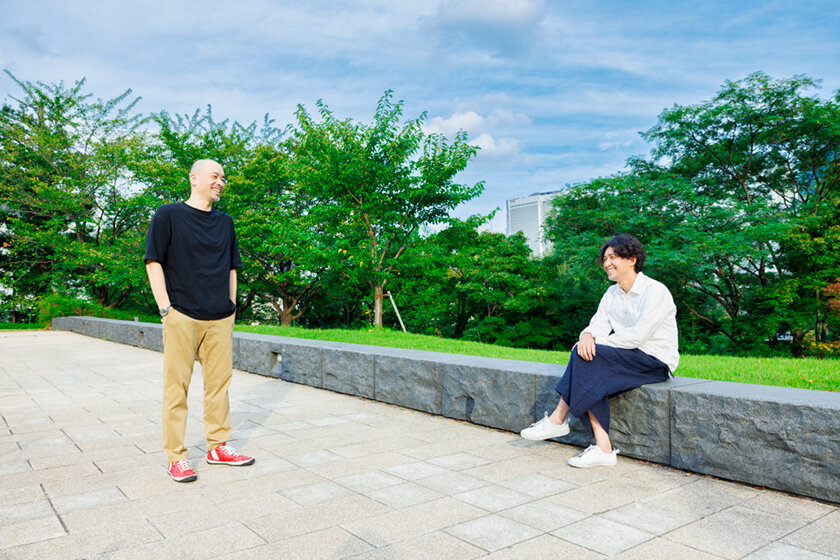
Electricity can alter the flow of people walking through the city
OnishiBeing in central Tokyo, Roppongi is an energy consumption area, but flipping it to being an energy production area would have a huge impact. The idea is a lot more realistic when limited to this area, and it would be really interesting if we could have the city say "The Roppongi declaration: We will become a producer of energy!" It can be really small-scale, like with a pedal-powered bicycle generator or generating power with solar panels. Whatever the scale, innovation like that in Roppongi may help drive change in Tokyo.
AshidaI like the idea of a Roppongi power generation project, too. During the first year of the Obuse project, we spread out a map of the town with residents and discussed concrete possibilities about where and how to best set up energy sources such as solar panels and wind turbines. Like Onishi says, I think it would be worthwhile to think about whether Roppongi has the potential to be a town that produces energy and if so, what the best way would be to go about it.
One interesting idea in terms of bonding energy and society together is a system that works like Pokémon GO, which was all the rage some years ago. You know how it got people to gather in completely unremarkable places in the city with their eyes on their smartphones? I think being able to control the flow of people like that has a lot of potential for applications. For example, many people are on the lookout for outlets or Wi-Fi when walking around town, right? I do this too, but people sometimes decide to enter a cafe based on outlet or Wi-Fi availability. In other words, electricity now has the power to attract people in a big way, so we should theoretically be able to alter the flow of people by surreptitiously setting up charging stations around the area. I think it might be interesting to do that at an event or in front of a store or something and try to create distinct pools of people.
OnishiHow about adding bicycle generators to the charging stations and say, "If you want to charge your device you should generate some power, too"? [laughs]
AshidaThat would be interesting. I do think electricity has that much influence over people nowadays.
OnishiAt the moment, I figure the only way urban dwellers can contribute energy-wise is through using energy efficiently. But I think there's something that could be done in Roppongi from an energy generation perspective that goes beyond that.
AshidaLooking at the "generation" aspect is very important. Relating to the idea of cyclic systems and sustainability, energy efficiency and saving on power is a negative action that involves refraining from or cutting back on energy use, which requires self-restraint. Switching to the positive action of generating energy instead would make for a much more enjoyable lifestyle. This may sound extreme, but I think moving toward a society where you're supposed to generate the energy that you use, might actually lead to more people leading healthy and enjoyable lives. Roppongi is a town of design as well, so I think it could give rise to some unique ideas for how to generate electricity that go beyond simply setting up some solar panels.
Energy can be an attractive force that connects people
OnishiI mentioned my cricket research earlier, but I'm currently involved in a project called ENTOMFARM to farm crickets for human consumption. I've included a bit of this in the DESIGN TOUCH exhibition as well. We use a 3D printer to create three dimensional truncated octahedron structures. When you raise crickets packed in these structures, it only takes four to six short weeks for them to develop into a food product rich in animal protein. I have an interest in food issues from an energy design perspective, which is why I'm conducting research on insects as a food source.
ENTOMFARM
There are high hopes for using edible insects as a next-generation alternative animal protein. With a focus on crickets, which the edible insect industry considers particularly efficient with good potential, the project aims to develop a design for a practical cultivation system.
AshidaWhat I'm the most interested in is what it means for something to be public. Up until now, the majority of cities were made by having the government create public spaces and private entities do their own thing on their own land. However, I think the way public spaces are formed will change from here on out. Being "public" is basically about community connections, and I think communities will shift to have more individuals coming forward. When that happens, a key factor will be the communal assets. Some kind of attractive force is necessary for people to connect, be it a facility, event, or some other thing that appeals to people, and energy is one example. Everyone coming together to generate and share energy is sure to help with community development. That's exactly what we've started doing in Obuse Town, so I hope that we will be able to create even more innovative models going forward.
Editor's thoughts
I had always thought that energy was too big a challenge for an individual or small organization to take on. Talking to the two from ENERGY MEET made me realize just how important the power of design is for connecting people and organizations, as well as for devising a path toward improvement and solutions. (They were also an amazing team!) Roppongi has the image of being a major energy consumer, and the idea to convert it into a producer of energy by breaking down the bloated city into smaller sections is so inspiring. If design could materialize a system that generates power from all the desire that churns within the city, that might just change the future. (text_ikuko hyodo)
RANKING
ALL
CATEGORY







